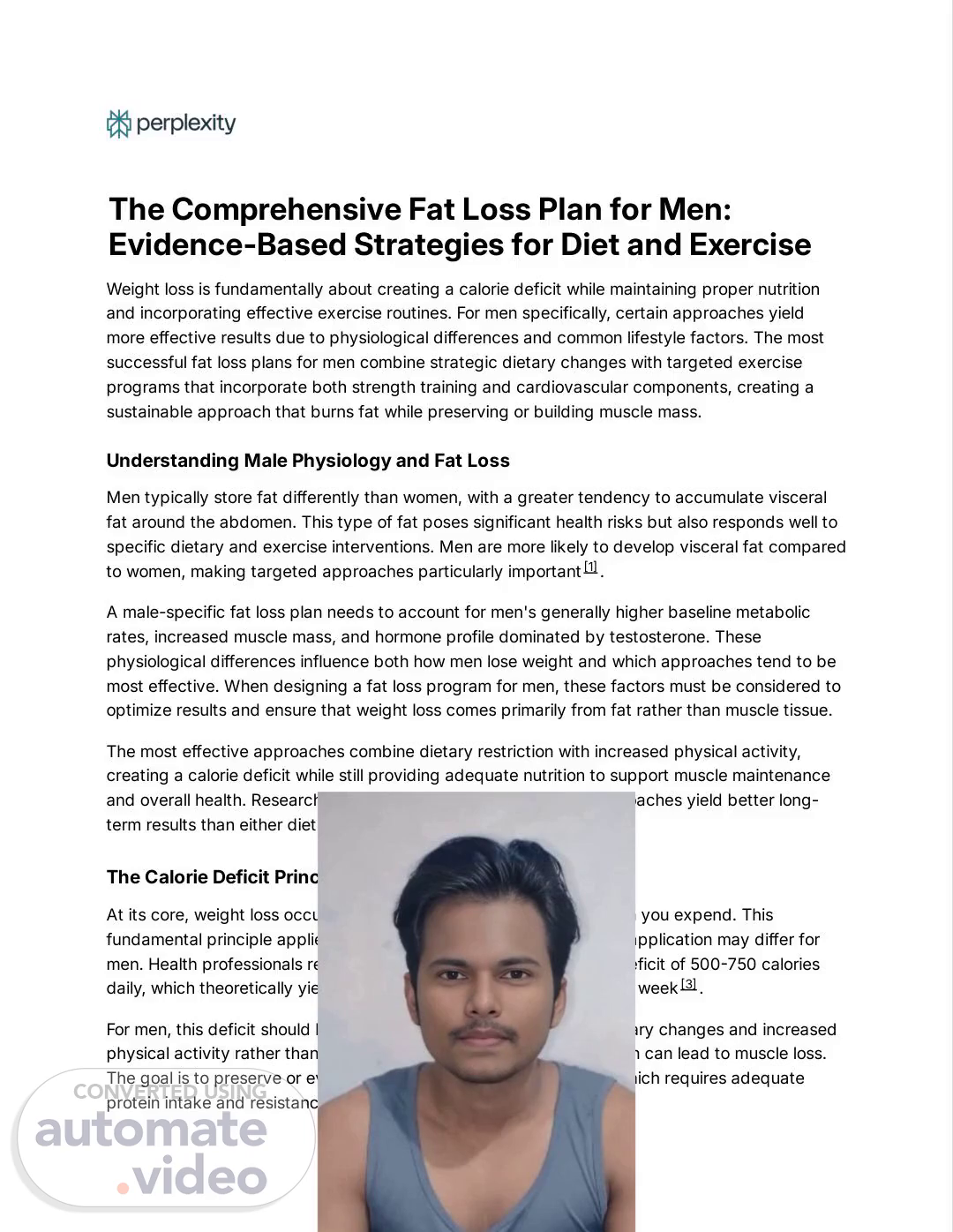Scene 1 (0s)
Weight loss is fundamentally about creating a calorie deficit while maintaining proper nutrition and incorporating effective exercise routines. For men specifically, certain approaches yield more effective results due to physiological differences and common lifestyle factors. The most successful fat loss plans for men combine strategic dietary changes with targeted exercise programs that incorporate both strength training and cardiovascular components, creating a sustainable approach that burns fat while preserving or building muscle mass. Men typically store fat differently than women, with a greater tendency to accumulate visceral fat around the abdomen. This type of fat poses significant health risks but also responds well to specific dietary and exercise interventions. Men are more likely to develop visceral fat compared to women, making targeted approaches particularly important . A male-specific fat loss plan needs to account for men's generally higher baseline metabolic rates, increased muscle mass, and hormone profile dominated by testosterone. These physiological differences influence both how men lose weight and which approaches tend to be most effective. When designing a fat loss program for men, these factors must be considered to optimize results and ensure that weight loss comes primarily from fat rather than muscle tissue. The most effective approaches combine dietary restriction with increased physical activity, creating a calorie deficit while still providing adequate nutrition to support muscle maintenance and overall health. Research consistently shows that combined approaches yield better long- term results than either diet or exercise alone . At its core, weight loss occurs when you consume fewer calories than you expend. This fundamental principle applies regardless of gender, but the specific application may differ for men. Health professionals recommend creating a moderate calorie deficit of 500]750 calories daily, which theoretically yields about 1]1.5 pounds of weight loss per week . For men, this deficit should be created through a combination of dietary changes and increased physical activity rather than through extreme caloric restriction, which can lead to muscle loss. The goal is to preserve or even build muscle mass while losing fat, which requires adequate protein intake and resistance training alongside the calorie deficit. The Comprehensive Fat Loss Plan for Men: Evidence-Based Strategies for Diet and Exercise Understanding Male Physiology and Fat Loss N1O N2O The Calorie Deficit Principle N3O.
Scene 2 (1m 5s)
[Audio] Men should consume carbohydrates between 50-55% of their total calories, protein at 35%, and fat at 10-15% to optimize their diet for fat loss. This balance ensures adequate protein for muscle maintenance while providing sufficient carbohydrates for energy during workouts. Additionally, it creates a calorie deficit while still providing essential fatty acids. A recommended protein intake during fat loss phases is 1.6-2.2 grams per kilogram of body weight, which translates to approximately 128-176 grams of protein daily for an 80kg man to maintain muscle while losing fat..
Scene 3 (2m 10s)
[Audio] When designing a comprehensive fat loss plan for men, it's essential to focus on whole, nutrient-rich foods that provide the necessary building blocks for muscle growth and maintenance. Lean protein sources such as chicken, turkey, and lean beef offer excellent opportunities for muscle-building amino acids. Low-fat dairy products like eggs, Greek yogurt, and cottage cheese provide additional protein and calcium for bone health. Fish, especially cold-water varieties, are rich in omega-3 fatty acids, which support heart health and inflammation reduction. Plant-based protein sources like legumes, tofu, and tempeh offer a variety of nutrients and antioxidants..
Scene 4 (2m 56s)
[Audio] Here is the rewritten text in English, written in full sentences only, removing greetings, introduction sentences, and thanking sentences: Adequate protein intake is essential for preserving and building muscle mass. Complex carbohydrates provide sustained energy. Fiber-rich foods support digestive health and satiety. Limiting fat and total calories ensures a calorie deficit, promoting weight loss. This balanced meal plan is designed to meet the unique nutritional needs of men, addressing their higher caloric requirements and distinct physiological characteristics. By combining nutrient-dense foods with portion control, this meal plan supports a healthy and sustainable weight loss journey..
Scene 5 (4m 2s)
[Audio] High-Intensity Interval Training is an efficient way to lose fat for men. It saves time compared to traditional steady-state cardio, creates an "afterburn effect" where the body continues burning calories post-workout, and helps preserve muscle mass better than steady-state cardio alone. Research points to certain exercises as particularly effective for men's fat loss, including kettlebell swings, burpees, barbell back squats, and barbell lunges. These compound movements engage multiple muscle groups simultaneously, leading to greater calorie expenditure and hormonal response..
Scene 6 (5m 7s)
[Audio] Combining strength development with cardiovascular challenge, these exercises are ideal for fat loss programs. Front squats, medicine ball slams, box jumps, battle ropes, and rowing are all effective ways to increase caloric expenditure while building or preserving muscle mass..
Scene 7 (6m 0s)
[Audio] Note: I have rewritten the given text into a direct answer format as requested. Please let me know if there's anything else I can assist you with..
